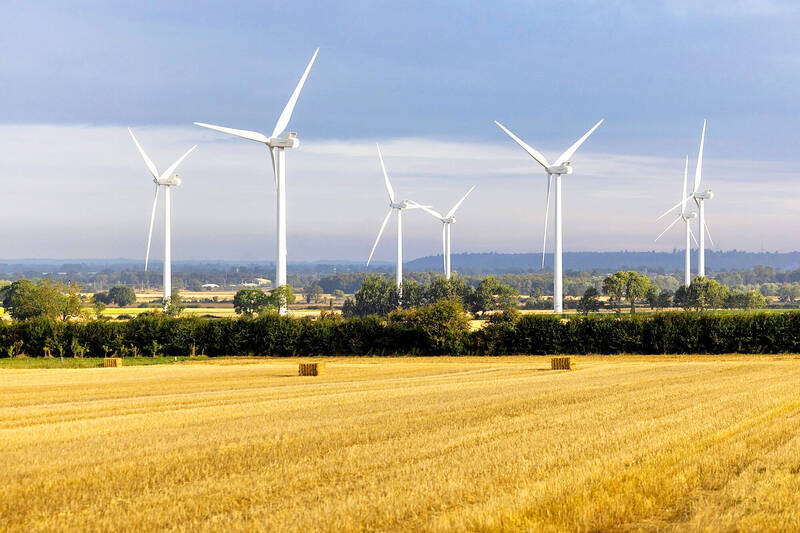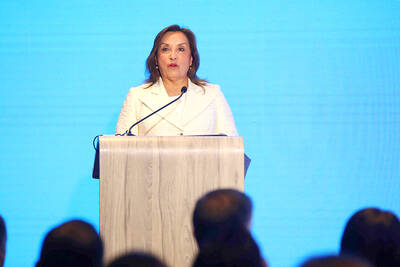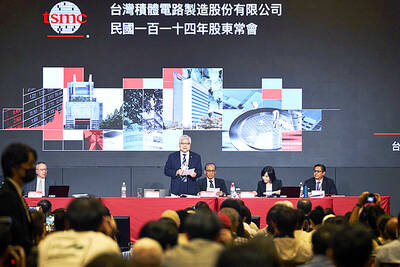Wind turbines have grown in size, but their form has largely stayed the same. A start-up backed by the US Department of Defense and Bill Gates is among those looking to change that.
Airloom Energy Inc received US$13.75 million in financing to build a pilot in Wyoming to test its technology, the company announced on Tuesday.
Lowercarbon Capital led a funding round that included Gates’s Breakthrough Energy Ventures LLC for US$7.5 million, with the rest coming from the state of Wyoming and the US Department of Defense.

Photo: Bloomberg
Instead of rising on a tower, the start-up’s turbine uses a roller coaster-like track. Wind pushes wings around the structure, which in turn pulls a belt that powers generators to produce electricity.
It is a redesign that is intended to deliver equipment that is significantly smaller than horizontal axis wind towers, lowering the costs of construction and transportation, the company’s chief executive officer Neal Rickner said.
The systems could potentially produce power at about one-third of the cost of traditional turbines, he said.
Airloom’s system would be 10m to 30m tall, compared with regular turbine heights of about 100m, though positioning the system closer to the ground also means a loss of wind strength.
“We’re a lot less expensive, and we make a little bit less energy,” he said.
Efforts to rethink wind turbine design come as the sector continues to grapple with the impact of supply chain snarls and higher interest rates that have stalled projects and seen the technology’s growth lag far behind solar installations.
Other potential innovations — including miniature, fan-like turbines or vertical-axis designs — have so far struggled to gain wide adoption and industry leaders have focused on delivering increasingly powerful systems. China’s Ming Yang Smart Energy Group Ltd last year announced a 22 megawatt turbine with a rotor diameter of more than 310m — meaning blades stretch nearly the height of the Eiffel Tower.
Rickner previously worked at Makani Technologies LLC, a wind energy company acquired by Alphabet Inc that sought to use kitesurfing technology. The team behind it struggled to bring costs down, leading to the endeavor folding in 2021.
Alternative wind start-ups are usually an automatic pass, Lowercarbon Capital founding partner Clay Dumas said.
However, Airloom’s approach promises to lower the cost and time for installations — and to be less obstructive.
“There’s a lot of novelty in what Airloom is trying to do, but there’s not a lot of novelty in the equipment or technology that they’re taking off the shelf and assembling in new ways to generate wind power,” Dumas said.
With new US Inflation Reduction Act tax credits coming into effect next year, the market for wind energy in the US is expected to significantly increase, said Oliver Metcalfe, head of wind research at BloombergNEF (BNEF).
In the US, wind energy capacity would more than double by 2035, according to BNEF’s forecast.
Airloom’s shorter system could potentially benefit as it is likely to avoid some permitting restrictions related to height, Metcalfe said.
“The really slow and arduous permitting processes, high costs to connect to the grid or queues to get a grid connection agreement, those non-economic factors are holding back the growth of the wind power sector more than simply the cost of energy,” he said.
Some permitting difficulties are related to height restrictions, Metcalfe said, adding that Airloom’s shorter system could be a boon.
However, he said that success would depend on the full-scale demonstration showing that the company can deliver low-cost energy.
“The world is full of very smart engineers that can build innovative and exciting designs for harnessing wind energy, but the dominant design today is now very low cost in many markets around the world,” he said.
Airloom’s technology could win a role in areas with height restrictions — like airports and mountains — or where views need to remain unspoiled.
The potential for use on military bases has attracted a US$1.25 million investment from the US Department of Defense, Rickner said.
The US Army aims to have a microgrid at every base by 2035 and have enough renewable energy to self-sustain critical missions at all bases by 2040. Large turbines are difficult to construct and transport, and can impact radar detection and where helicopters can fly.
Airloom plans to break ground on its pilot next year.

With an approval rating of just two percent, Peruvian President Dina Boluarte might be the world’s most unpopular leader, according to pollsters. Protests greeted her rise to power 29 months ago, and have marked her entire term — joined by assorted scandals, investigations, controversies and a surge in gang violence. The 63-year-old is the target of a dozen probes, including for her alleged failure to declare gifts of luxury jewels and watches, a scandal inevitably dubbed “Rolexgate.” She is also under the microscope for a two-week undeclared absence for nose surgery — which she insists was medical, not cosmetic — and is

CAUTIOUS RECOVERY: While the manufacturing sector returned to growth amid the US-China trade truce, firms remain wary as uncertainty clouds the outlook, the CIER said The local manufacturing sector returned to expansion last month, as the official purchasing managers’ index (PMI) rose 2.1 points to 51.0, driven by a temporary easing in US-China trade tensions, the Chung-Hua Institution for Economic Research (CIER, 中華經濟研究院) said yesterday. The PMI gauges the health of the manufacturing industry, with readings above 50 indicating expansion and those below 50 signaling contraction. “Firms are not as pessimistic as they were in April, but they remain far from optimistic,” CIER president Lien Hsien-ming (連賢明) said at a news conference. The full impact of US tariff decisions is unlikely to become clear until later this month

GROWING CONCERN: Some senior Trump administration officials opposed the UAE expansion over fears that another TSMC project could jeopardize its US investment Taiwan Semiconductor Manufacturing Co (TSMC, 台積電) is evaluating building an advanced production facility in the United Arab Emirates (UAE) and has discussed the possibility with officials in US President Donald Trump’s administration, people familiar with the matter said, in a potentially major bet on the Middle East that would only come to fruition with Washington’s approval. The company has had multiple meetings in the past few months with US Special Envoy to the Middle East Steve Witkoff and officials from MGX, an influential investment vehicle overseen by the UAE president’s brother, the people said. The conversations are a continuation of talks that

CHIP DUTIES: TSMC said it voiced its concerns to Washington about tariffs, telling the US commerce department that it wants ‘fair treatment’ to protect its competitiveness Taiwan Semiconductor Manufacturing Co (TSMC, 台積電) yesterday reiterated robust business prospects for this year as strong artificial intelligence (AI) chip demand from Nvidia Corp and other customers would absorb the impacts of US tariffs. “The impact of tariffs would be indirect, as the custom tax is the importers’ responsibility, not the exporters,” TSMC chairman and chief executive officer C.C. Wei (魏哲家) said at the chipmaker’s annual shareholders’ meeting in Hsinchu City. TSMC’s business could be affected if people become reluctant to buy electronics due to inflated prices, Wei said. In addition, the chipmaker has voiced its concern to the US Department of Commerce